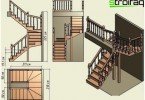Handrails and railings for stairs
Railings are usually called fences of various configurations, which, firstly, serve to ensure convenient movement along the stairs and prevent a person from falling outside the enclosed structure, and secondly, they are a fairly noticeable element of the interior. Handrails are a narrower concept that corresponds to the upper part of the railing, it is they who are held by a person when climbing or descending from a staircase. Railings and handrails for stairs are an integral part of them, and no reservations are provided in this case. The lack of a guardrail and a handrail on the stairs is a serious violation of safety regulations, therefore, designers and builders usually object to those customers who, for whatever reason, want to do without this structural element.
Content
- What is the difference between railing and handrails?
- Ladder Requirements
- Advantages and disadvantages of different materials
- How to install yourself?
What is the difference between railing and handrails?
In order to avoid confusion, you need to clearly understand the difference between the railing and handrails, since on the same staircase combinations of handrail and handrail elements from different materials are possible that will organically look in the interior. However, non-specialists often call handrails handrails and vice versa, which can lead to misunderstanding with designers, builders, consultants of building stores.
The railing is an integral part of the staircase design, so it is assumed that they should be made in the same style and from the same materials, although today some designers suggest experimenting in these areas. In most cases stairs are made of metal or wood. The range of materials for the manufacture of handrails is slightly wider – in addition to metal and wooden, there are glass railings for stairs, as well as PVC railings.
Ladder Requirements
Whatever material is chosen, do not forget some rules that are common for fences of all types and are mandatory for execution in terms of safe operation of the stairs:
- the outer side of the stairs should be equipped with a railing;
- if the staircase is less than one meter wide, then at least one side should have a railing or handrail installed, even if the staircase is bounded on both sides, for example by walls;
- if the width of the stairs is more than one meter, then the handrails should be installed on both sides;
- if the stairs have rungs, then from the side where they are wider, there must be a railing.
The height of the railing on the stairs is also clearly regulated: it is assumed that on average it is equal to the distance from the feet to the abdomen of a person, therefore, on the inter-story stairs, the height of the railing should be at least 90 centimeters, and the maximum distance between the racks should not exceed 15 centimeters.
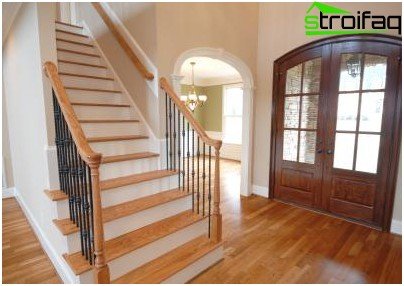
The installation of handrails and handrails in accordance with existing standards will make the operation of the stairs comfortable and safe..
Important! If children use the stairs, then these figures are respectively 150 and 10 centimeters. Also, the design of the fences should be such that small children could not climb them.
Advantages and disadvantages of different materials
The railing and handrails of the stairs can be made of the same material or from different combinations of metal, wood, glass or pvc. Each of the proposed options has both advantages and disadvantages, which are best known before the installation of the stairs..
The most common material for the railing, and even more so for the handrails, is wood. Even if the fence itself is planned to be made of another material, experts will advise installing wooden handrails for the stairs or their imitation of pvc. Handrails for wooden staircases are popular for several reasons, among which the widespread use of wood as a building material, the affordability of non-elite wood species, environmental friendliness and texture of wooden products. This is especially true for handrails, because it is with them that the palm of a person contacts when operating the ladder.
However, wooden railings for stairs also have drawbacks, of which their relative fragility, limited use (considered mainly for interior decoration, as the wood is susceptible to various external influences like high humidity, heat, sudden changes in temperature) and the high cost of valuable species are considered the most unpleasant. wood.
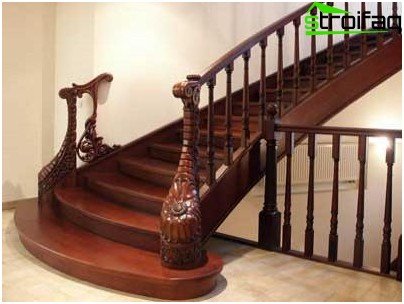
Intricate carvings turn a wooden railing into a work of art
If for some reason the tree is not suitable as a fence, you can install metal railings for stairs that are reliable in operation, affordable, harmoniously fit into an interior decorated in any style. Some people believe that metal handrails for stairs are not as pleasant to the touch as wooden ones, but this belief is largely erroneous – the sliding cool surface of the handrails made of metal or stainless steel does not cause repulsive sensations. But, if the prejudice is still stronger than rational arguments, you can install wooden handrails on the metal fence, which will give the whole structure a complete look.
Railing for stairs made of metal has another important drawback – fences of a simple standard form, simple to manufacture, affordable for almost everyone, but intricate openwork forged railings for stairs, which are the pride of the owners and the envy of the guests, will cost significantly more.
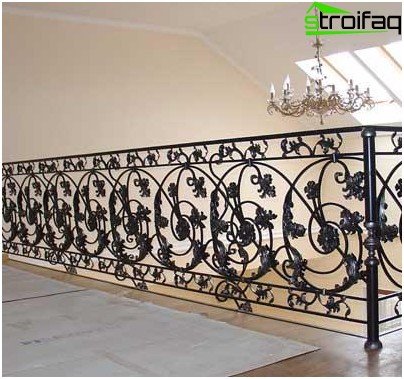
Forged railings look luxurious and can serve not only as a fence, but also as an important element of decor
Alternatively, you can consider installing instead of the usual balusters made of wood or metal decorative glass inserts, which today are considered the most elegant and sophisticated. Wide possibilities of glass decoration will make it possible to realize the most unexpected design decisions.
If the staircase, according to the plan of the customer, has an unusual shape or a too sharp bend, then wood or metal may not be able to cope with the task. But the handrails for PVC stairs are suitable for such cases: their main advantage is the possibility of bending using special devices, and additional – such handrails can imitate the texture of the tree, they are durable and practical.
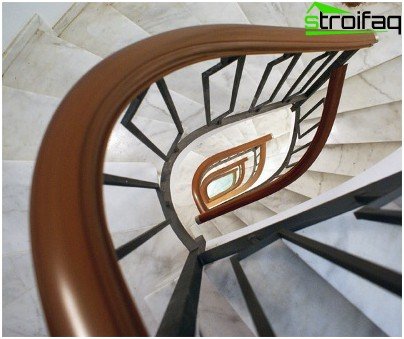
Due to the plasticity of pvc railing from this material, you can give any curved shape
How to install yourself?
Experienced masters argue that making a railing for stairs with your own hands is quite realistic if you follow clear instructions and do not violate the basic installation rules:
- Before making a railing for the stairs, all necessary calculations should be made taking into account additional factors (for example, the use of the stairs by children or the elderly);
- after that, make markings on the wall on which the handrail is supposed to be installed, and on the surfaces on which supporting balusters will be installed that carry the entire structure of the fence;
- when this work is done, you can proceed with the installation of simple balusters and fasteners.





